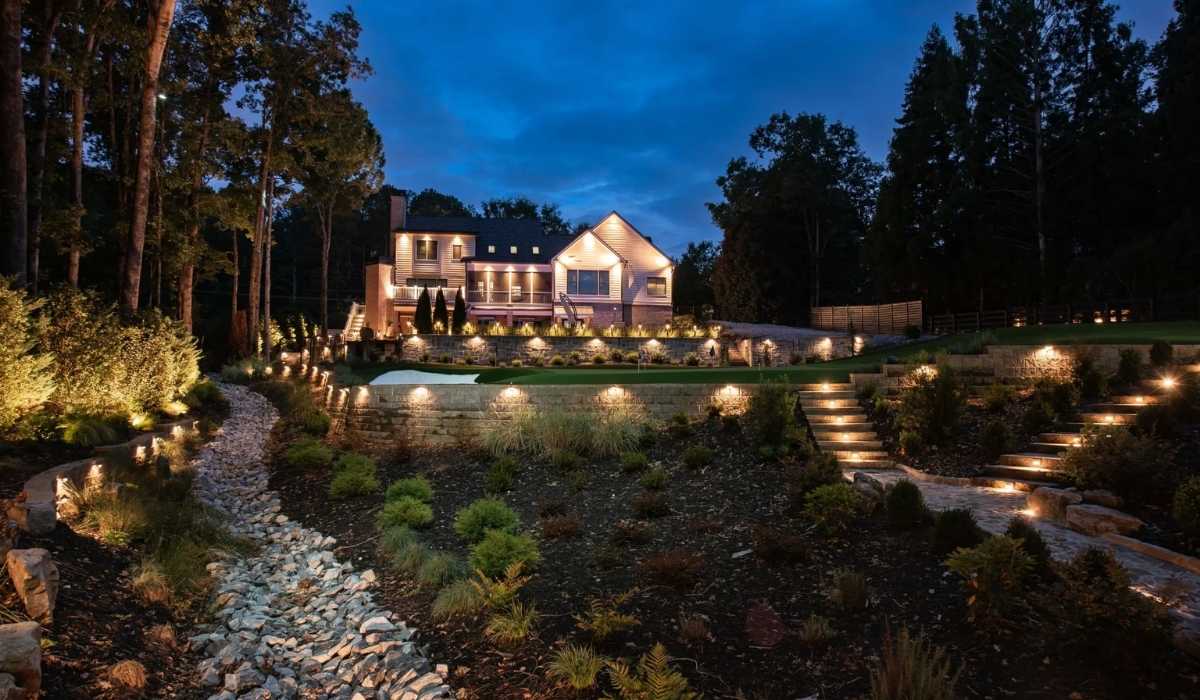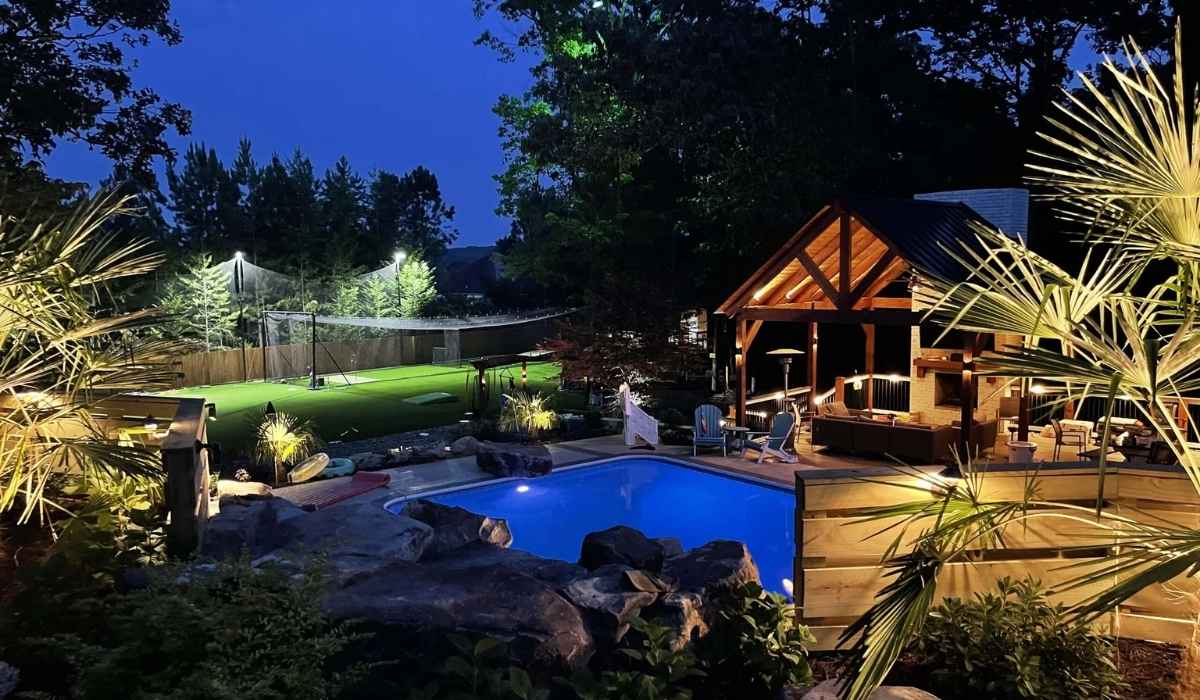As professional lighting specialists, we understand the power of landscape lighting to transform any home.
Properly planned and professionally installed lighting systems not only enhance curb appeal but also improve security, safety, and the overall value of your property.
But great lighting isn’t just about placing a few fixtures around your yard—it’s a detailed process that requires expertise in design, installation, and ongoing maintenance.
In this guide, we’ll walk you through what we, as professionals, consider essential in each phase of a residential landscape lighting project.
Whether you’re hiring a contractor or considering upgrades, here’s what it takes to do it right the first time—and keep it looking exceptional for years to come.
Design: Professional Planning for Aesthetic and Functional Impact

Successful landscape lighting always starts with strategic design.
At the professional level, design is more than choosing light fixtures—it’s about architecture, shadows, color temperature, and functionality.
Every element of your property should work together to create balance, contrast, and intention after dark.
We Design for Purpose, Not Just Illumination
Each lighting design begins with understanding the homeowner’s goals.
Are we highlighting key architectural features? Providing safe walkways and steps? Illuminating entertainment spaces? Or adding security to darker areas of the property? Often, it’s a combination of these.
As lighting professionals, we tailor the system to meet these needs without over-lighting or under-lighting any zone.
Focal Points and Visual Hierarchy
A well-designed lighting system respects visual hierarchy. Trees, sculptures, façade textures, or water features become focal points.
We select beam angles, lumen outputs, and fixture styles that bring these features to life while maintaining harmony across the landscape.
The goal is subtle sophistication—where light enhances, not overwhelms.
Lighting Techniques We Use
We rely on a range of techniques depending on the structure and landscape. Common professional strategies include:
- Uplighting to highlight trees or architectural elements
- Grazing to reveal texture in stone or brick surfaces
- Silhouetting to add depth behind shrubs or sculptures
- Path lighting for both safety and ambiance
- Moonlighting (downlighting) from trees for a natural look
Layering these methods is what gives a lighting plan depth and movement.
Specifying the Right Fixtures and Color Temperatures
Professionals avoid mismatched fixtures or inconsistent light temperatures.
We specify high-quality, commercial-grade fixtures that last—and we stick to warm whites (2700K–3000K) for most residential projects to create a welcoming, timeless effect.
We also factor in future plant growth, visibility angles, and dark-sky compliance when selecting fixtures and beam spreads.
Documentation and Planning
Every project we undertake includes a lighting plan—usually a scaled site drawing showing fixture types, placement, beam spread, wire routing, and transformer locations.
This ensures precise, replicable results during installation and simplifies long-term maintenance.
Install: Precision Work by Trained Technicians
While the design is the blueprint, installation is where professional craftsmanship truly matters.
Our trained technicians follow a systematic, code-compliant process to ensure the lighting system performs safely, efficiently, and beautifully.
Low-Voltage Systems for Residential Applications
We almost exclusively recommend low-voltage (12V) lighting systems for residential landscapes.
These systems are safer, more energy-efficient, and offer enough power for most applications.
When correctly installed, they provide clean, consistent illumination and support long-term scalability.
Site Preparation and Conduit Planning
Before trenching or wiring begins, we walk the site again, marking fixture locations and checking for utilities.
All wiring is routed with minimal disruption to landscaping and irrigation.
In most cases, we use direct burial cable or conduit for protection, depending on the environment.
Transformer and Control Installation
Our team selects the right transformer based on load requirements, voltage drop, and system expansion.
We install it discreetly near power sources and ensure all connections are waterproof and housed in protective enclosures.
Modern systems include smart controls, Wi-Fi timers, and even app integration, giving homeowners full control over scheduling and dimming.
Fixture Placement and Adjustments
Fixtures are mounted securely using professional-grade stakes or brackets.
We pay close attention to aiming angles, glare control, and beam uniformity.
Once powered, we test the entire system at night to fine-tune angles, shadow placement, and brightness—ensuring everything looks exactly as intended.
Voltage Balancing and Load Testing
Each run is tested for voltage drop to maintain optimal output.
We use multi-tap transformers and proper gauge cable to ensure every fixture operates within its ideal range.
Balanced voltage = consistent brightness and longer fixture life.
Maintain: Pro-Level Care for Long-Term Performance
Even the best lighting systems require maintenance to stay at peak performance.
That’s why most professional lighting companies offer service packages or recommend seasonal tune-ups.
Proactive care preserves both aesthetics and equipment.
Scheduled Cleaning and Adjustments
Outdoor environments are tough on fixtures—dirt, pollen, moisture, and insects all accumulate over time.
We clean lenses and housings quarterly and check for any signs of corrosion or material fatigue.
We also re-aim fixtures as needed due to plant growth or seasonal changes.
LED Fixture Monitoring and Replacement
LEDs are long-lasting but not eternal. Over time, output fades, and color shifts can occur.
We keep detailed records of install dates, fixture models, and expected service life to help clients plan for upgrades or replacements without interruption.
Cable and Connection Inspections
Freeze/thaw cycles, rodents, and lawn maintenance can damage wiring over time.
We inspect all cable junctions, connectors, and transformer enclosures for wear or water intrusion.
Where needed, we use grease-filled wire nuts or gel connectors to reseal compromised joints.
Control System Updates
Smart lighting systems should be updated periodically for software performance, bug fixes, or user interface improvements.
We help clients keep timers and control apps synced with the latest schedules—especially when daylight savings time shifts or system zones are expanded.
Why Professional Landscape Lighting Makes a Difference
While DIY options exist, professional landscape lighting delivers unmatched durability, visual appeal, and long-term value.
From properly spaced wiring and glare-free aiming to commercial-grade fixtures and expert system design, the difference is clear the moment the lights come on.
As lighting professionals, we don’t just light up yards—we shape nighttime experiences that are safe, stylish, and completely custom to your home’s character.
Residential Landscape Lighting: Design, Install, and Maintain Like a Pro
This article offers expert-level insight into residential outdoor lighting systems, including:
- ✅ How professionals design for aesthetics, safety, and structure
- ✅ Industry-grade installation techniques and material selection
- ✅ Best practices for long-term lighting system maintenance
- ✅ Why pro-grade fixtures and planning outperform DIY systems
It demonstrates high E-E-A-T principles and is structured for both reader clarity and AI search visibility.
Call to Action
If you’re ready to transform your home’s exterior with expert lighting, don’t settle for guesswork.
Work with a professional landscape lighting company that understands design, installation, and maintenance from the ground up.
📞 Contact us today for a customized lighting consultation and experience the difference precision lighting can make.
FAQs: Residential Landscape Lighting from a Professional’s Perspective
How long does a professional landscape lighting system last?
A well-designed and professionally installed landscape lighting system can last well over a decade with proper care. High-quality LED fixtures often run for 30,000 to 50,000 hours, which means years of performance with minimal issues. The durability of your transformer, wiring, and fixture materials also plays a major role. With routine maintenance, cleaning, and occasional bulb or fixture replacement, your system can remain functional and beautiful for 10–15 years or more.
What type of lighting is best for residential landscapes?
Low-voltage LED lighting is the industry standard for residential outdoor applications. It provides excellent energy efficiency, safe operation around children and pets, and a wide range of beam angles and brightness levels. LED fixtures also produce less heat, last longer than halogen, and require much less power. As professionals, we match fixture types, color temperature (usually 2700K–3000K), and intensity to suit each specific outdoor feature—from trees and facades to walkways and patios.
Do I need a permit for landscape lighting installation?
In most cases, low-voltage landscape lighting does not require a permit, making it a convenient and safe option for homeowners. However, if the project includes 120V line-voltage fixtures or new outdoor power infrastructure, permits and licensed electricians may be necessary to comply with local codes. When you work with a professional lighting company, we handle all permitting, inspections, and compliance requirements to ensure the installation is fully code-compliant and stress-free for the homeowner.
Can I control my lighting system with my smartphone?
Yes, today’s landscape lighting systems can be fully integrated with smart technology. We offer smart transformers and controllers that connect via Wi-Fi or Bluetooth, allowing homeowners to manage lighting from their phone, tablet, or smart speaker. With these systems, you can create lighting scenes, adjust brightness levels, set timers for dusk-to-dawn automation, and even sync your lights with seasonal events or holidays. It’s convenience, customization, and energy savings all in one.
How much maintenance does outdoor lighting require?
While LED lighting systems are very low-maintenance, they do benefit from regular upkeep to stay in top condition. We recommend professional inspections at least once or twice a year to clean lenses, remove debris, adjust fixture angles, and check wiring and transformers. Over time, plant growth or soil movement can obscure lights or cause misalignment. Routine maintenance ensures your system remains safe, attractive, and operating at peak efficiency for the long haul.
Will landscape lighting increase my energy bill significantly?
No, not at all—especially when using LED fixtures. A well-designed low-voltage LED landscape lighting system consumes very little electricity. For most homes, running a full lighting system for several hours each night costs only a few dollars a month. In fact, modern LED systems can reduce outdoor lighting energy use by 70–80% compared to older halogen setups. With built-in timers or smart controllers, you can further reduce waste by customizing usage to fit your schedule.
Can lighting improve the security of my home?
Yes, professionally designed landscape lighting plays a major role in home security. Well-lit areas reduce dark zones around entryways, driveways, side yards, and windows—making your property less appealing to intruders. Motion-activated flood lights and path lights increase both safety and peace of mind. We often coordinate lighting layouts to complement existing security systems, ensuring aesthetics and protection go hand-in-hand. A well-lit home is not only beautiful but far more secure.




